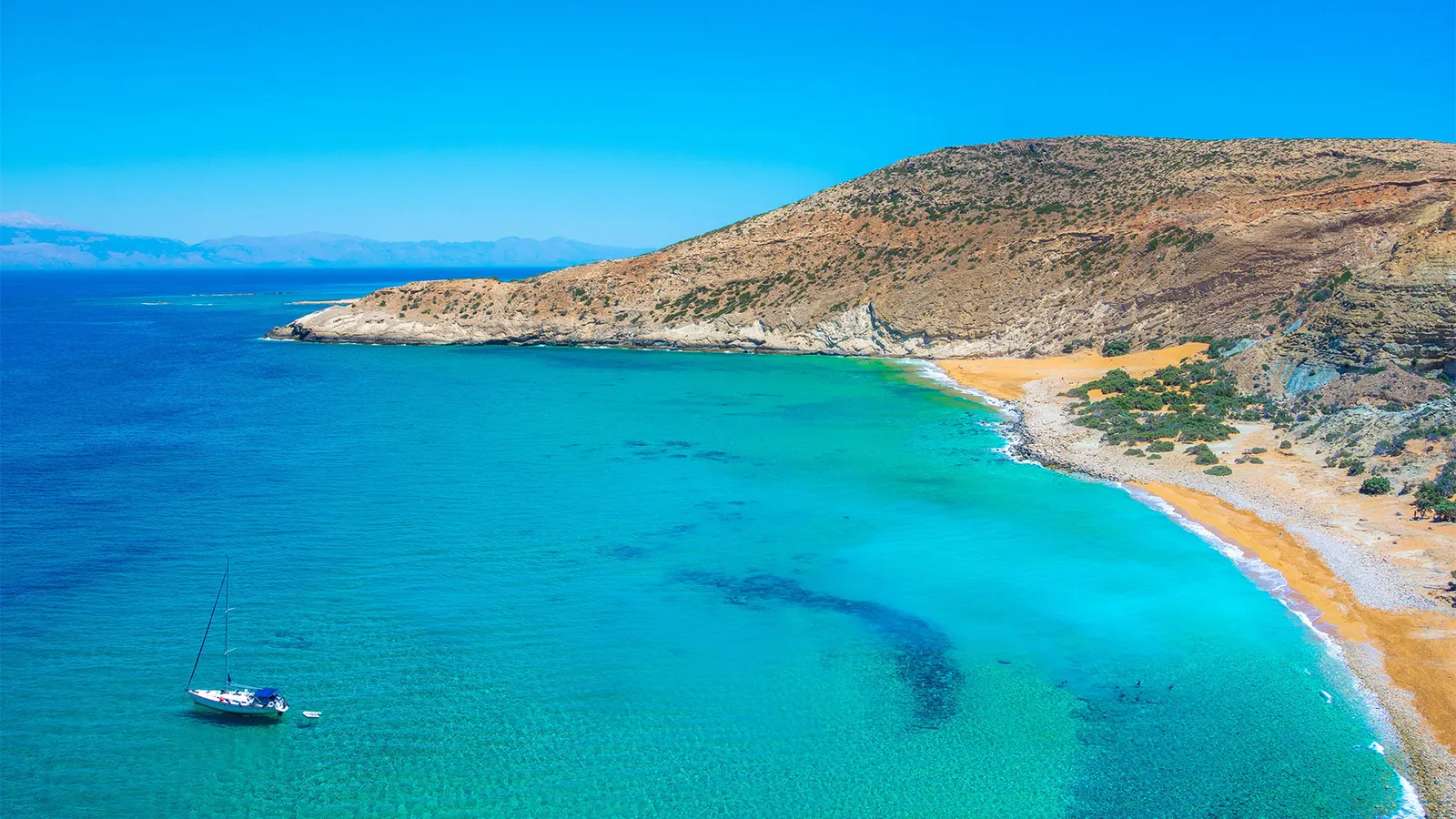Gavdos: The European island known for nudity
Marooned in the Mediterranean, this tiny Greek island has been a bohemian destination since the 1960s. But can its anything-goes culture survive?

I spent my last day on the Greek island of Gavdos at Sarakiniko, its largest and most popular beach. But when I arrived, a new wooden sign dug deep in the golden sand warned me: nudity was now prohibited.
Situated in the middle of the Libyan Sea 79km south of Crete, Gavdos is the southernmost point in Europe and, until recently, one of the only places in Greece where you were free to swim nude and sunbathe naked. According to a 1983 Greek law that was never revised, nudism in Greece is only officially allowed at nudist resorts, and while unofficial nude beaches can be found elsewhere in Greece, nowhere else in the country is there a stronger clothing-optional culture than here, where authorities have traditionally looked the other way.
"The freedom Gavdos offers, you can't find it anywhere else," said Vasilis Tzounaras, the former owner of Gavdos FM, the island's only radio station, who moved to the island about 20 years ago from Crete. "[I'll] probably stay here for the rest of my life. I never thought I'd see something like this on the island," he said, referring to the recent ban on nudity.
In July 2023, the mayor's office posted the signs at Sarakiniko, sparking controversy and protests among locals and tourists, most of whom live on or visit Gavdos because of its historical anything-goes attitude. However, speaking to a local news outlet, Gavdos' mayor, Lilian Stefanaki, said that only tourists were objecting to the ban. "The local residents have wanted this for years," she said, "to have at least one beach where a family can swim without the possibility of nudists around."
While the island's other beaches remain open to nude swimming, many worry that the recent ban on nudity at Sarakiniko may soon extend elsewhere in Gavdos, and thus endanger the island's DNA. In addition to swimming in the buff, the island is also famous for allowing free camping on its beaches, which is also prohibited elsewhere in Greece. This clothing-free right to roam is what has led thousands of backpackers and bohemian travellers to flood into the tiny island each summer since the 1960s.
"I heard there is an intention to also ban free camping on a large area of the island soon. If this happens, it will mark the end of the island and its economic development," said Gelli Kallinikou, Gavdos' former mayor. "When I was mayor, every year we had to officially [make] a decision that nudism and free camping are allowed in Gavdos … it was initiated by the community council in 1992 so that [nude bathers] would feel safe."
Yet, the history of this 30 sq km island runs much deeper than its counter-culture reputation. Gavdos is believed to be the mythical Ogygia, where, according to Homer, the nymph Calypso held Odysseus for seven years before he returned to his beloved Ithaca. In the 1930s, its far-flung location made it an ideal destination for the Greek government to exile alleged communists. But with the rise of hippie culture in the 1960s-'70s, Gavdos gained popularity as a boho holiday destination. Located far from any central government and with just 142 full-time residents in 1971, Gavdos soon became something of a alternative-lifestyle haven. People came to camp on the beach, light fires, cook their own meals and swim naked.
The day before I visited Sarakiniko, I hiked 10km south to the other side of Gavdos under a blazing-hot sun to reach the beach of Trypiti, where a 2.5m wooden chair cemented atop a rocky overlook marks the southernmost point of Europe. The chair was created by a handful of Russian scientists who arrived on Gavdos island after the Chernobyl nuclear disaster in 1986. It is rumoured the scientists were exposed to radiation, and Soviet doctors had prescribed them to stay in as pure of an environment as possible while they healed. During their stay, they built the chair and cemented it to the edge of the promontory so they could breathe fresh air and gaze out on the vastness of the sea. As I lowered myself onto the makeshift monument, the sea met the sky in an unbroken palette of blue.
From the beach of Trypiti, which means "hollow" in Greek and takes its name from the limestone rock formation resembling Malta's famous Azure Window where the chair sits, the nearest village is Vatsiana. There, I met Nikos Lougiakis who, along with his family of four, are the southernmost citizens of Europe.
"I [have] lived here all my life," Lougiakis said, as he took a sip from his glass of Greek iced coffee. "Being the first house everybody sees coming up from Trypiti, and without any mini market in the area, people coming from the beach usually stopped here and asked for some water, so I decided to open this small cafe-restaurant."
Nine years later, Lougiakis' cafe is now famous for his katsikaki tsigariasto, a traditional Cretan recipe where the meat of young goats is cooked in a casserole with olive oil and onions and is served with French fries. "I am the cook here and the meat is my own. I grow [the goats]," he said with pride, as he showed me a goat skull with large horns decorating his iron fence.
When asked about the mayor's recent decision, Lougiakis said he feared that this might change the whole vibe of the island. "Many people cancelled their trip this year because of this," he said. "Those people have helped me to raise my family. They spend money on the island, and they have never come to my restaurant naked. They respected me."
According to locals, there were significantly fewer visitors to Gavdos this summer than in previous years, and Sarakiniko was uncharacteristically empty when I visited. "Most people who would normally camp at Sarakiniko moved to the other beaches," Tzounaras told me.
VISITING GAVDOS
ANENDYK Seaways runs ferries to Gavdos from Hora Sfakion and Palaiochora in Crete. Free camping is allowed on the island, but there are also several rental accommodations. Oi Nostimies tis Eftihias at Metochi and Xelona at Sarakiniko are both hotels with dining options.
Sarakiniko is where most taverns and mini markets are located on Gavdos and where most tourists and islanders traditionally congregate. This summer, however, it was the scene of protests after the ban, as people came together to support an initiative by the Gavdos Visitors Initiative that encouraged people to protect the island's reputation by posting under the hashtag #Save_Gavdos on social media.
According to the 2021 census, 208 people live on Gavdos, though in reality, Tzounaras estimates that there are only about 70 full-time residents. Winters here can be hard. Strong winds can keep the ferries and valuable supplies away for days or even weeks on end, but residents say they make do. "In the summer, you see people passing by, but in winter there is almost no one," said Eleftheria Vailakaki, who lives just north of Lougiakis' family in Vatsiana. "
Public transportation is carried out with two old buses that bump along the island's few asphalt-and-gravel roads and whose floors are typically lined with sand. Ingredients like almond milk and gluten-free products have not yet reached Gavdos.
"Electricity came to the island about 25 years ago," Vailakaki said, as she tended to her 10 goats, five sheep and flock of free-range chickens. "Those early years, we used to do everything with our hands. There were no cars, we only had donkeys and we did everything with them" she remembered. "Now we have generators for electricity. The island is changing." Still, Vailakaki maintained: "There is nowhere like Gavdos." and urged me to come again next summer.
No one knows whether the nudity ban will extend to all of Gavdos' beaches next summer, or whether free camping will still be allowed. But as Kallinikou said, "In Gavdos, both naked and clothed always coexisted … [here], you feel that you can fly, you can spread your wings and fly."
-bbc







